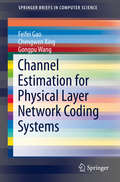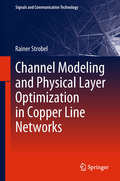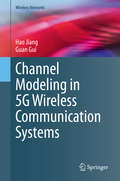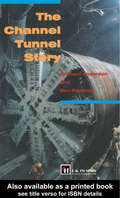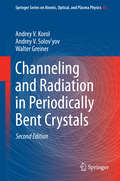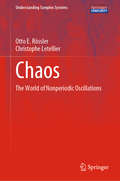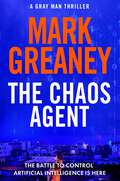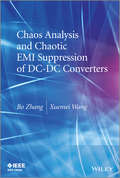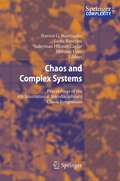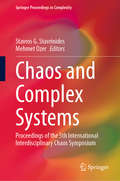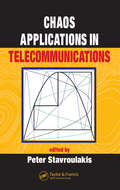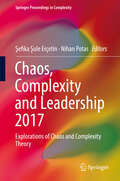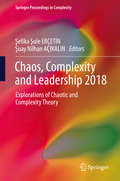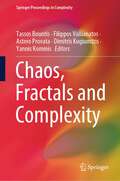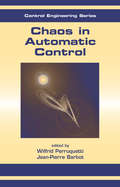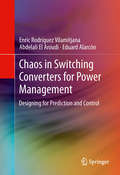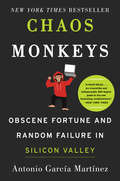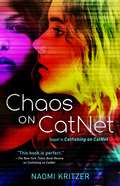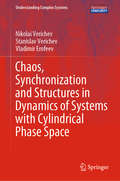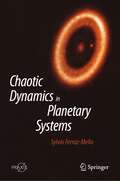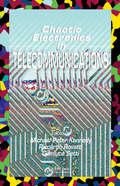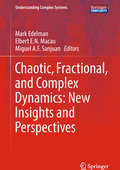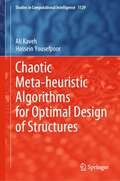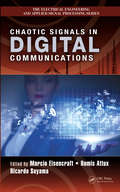- Table View
- List View
Channel Estimation for Physical Layer Network Coding Systems (SpringerBriefs in Computer Science)
by Feifei Gao Chengwen Xing Gongpu WangThis SpringerBrief presents channel estimation strategies for the physical later network coding (PLNC) systems. Along with a review of PLNC architectures, this brief examines new challenges brought by the special structure of bi-directional two-hop transmissions that are different from the traditional point-to-point systems and unidirectional relay systems. The authors discuss the channel estimation strategies over typical fading scenarios, including frequency flat fading, frequency selective fading and time selective fading, as well as future research directions. Chapters explore the performance of the channel estimation strategy and optimal structure of training sequences for each scenario. Besides the analysis of channel estimation strategies, the book also points out the necessity of revisiting other signal processing issues for the PLNC system. Channel Estimation of Physical Layer Network Coding Systems is a valuable resource for researchers and professionals working in wireless communications and networks. Advanced-level students studying computer science and electrical engineering will also find the content helpful.
Channel Modeling and Physical Layer Optimization in Copper Line Networks (Signals and Communication Technology)
by Rainer StrobelThis book investigates the physical layer aspects of high-speed transmission on twisted-pair copper wires, where the most performance-critical components are multi-input multi-output (MIMO) precoding and multi-line spectrum optimization as well as optimized scheduling of the transmission time slots on the fiber to the distribution point (FTTdp) copper link. The book brings theoretical results into the implementation, which requires the introduction of realistic channel models and more practical implementation constraints as found in the copper access network. A good understanding of the transmission medium, twisted-pair telephone cable bundles is the basis for this work. Starting from the analysis of measurement data from twisted-pair cable bundles at high frequencies, it presents a MIMO channel model for the FTTdp network, which allows the characteristic effects of high-frequency transmission on copper cable bundles in simulation to be reproduced and the physical layer transmission methods on the copper channels to be analyzed and optimize. The book also presents precoding optimization for more general power constraints and implementation constraints. The maximization of data rate in a transmission system such as G.fast or VDSL is a combinatorial problem, as the rate is a discrete function of the number of modulated bits. Applying convex optimization methods to the problem offers an efficient and effective solution approach that is proven to operate close to the capacity of the FTTdp channel. In addition to higher data rates, low power consumption is another important aspect of the FTTdp network, as it requires many access nodes that are supplied with power from the subscriber side over the twisted- pair copper wires. Discontinuous operation is a method of quickly adding and removing lines from the precoding group. To implement this, the system switches between different link configurations over time at a high frequency. The transmission times of all lines are jointly optimized with respect to the current rate requirements. Discontinuous operation is used to save power, but also makes it possible to further increase the data rates, taking the current subscriber traffic requirements into account. These methods are compared with theoretical upper bounds, using realistic channel models and conditions of a system implementation. The performance analysis provides deeper insights into implementation complexity trade-offs and the resulting gap to channel capacity.
Channel Modeling in 5G Wireless Communication Systems (Wireless Networks)
by Guan Gui Hao JiangThis book addresses the fundamental design and technical challenges for fifth generation (5G) wireless channel models, including multi-frequency bands and multi-scenarios. The book presents a strong vision for 5G wireless communication networks based on current market trends, proven technologies, and future directions. The book helps enable researchers and industry professionals to come up with novel ideas in the area of wireless heterogeneity, to minimize traffic accidents, to improve traffic efficiency, and to foster the development of new applications such as mobile infotainment. The book acts as a comprehensive reference for students, instructors, researchers, engineers, and other professionals, building their understanding of 5G and in designing 5G systems.Addresses fundamental design and technical challenges for 5G wireless channel models;Presents how to create reliable statistical channel models to capture the propagation properties between transmitters and receivers;Pertinent to researchers, engineers, and professionals in 5G.
The Channel Tunnel Story
by Graham Anderson Ben RoskrowThe Channel Tunnel is a huge construction project, employing over 14,000 people at peak, and costing over 11 billion of private money. It has succeeded in spite of great financial, political and techncial difficulties, and a fundamentally flawed contract. This book tells the story of the project, based on the coverage in Construction News and with
Channeling and Radiation in Periodically Bent Crystals (Springer Series on Atomic, Optical, and Plasma Physics #69)
by Walter Greiner Andrey V Korol Andrey V Solov'YovThe development of coherent radiation sources for sub-angstrom wavelengths - i.e. in the hard X-ray and gamma-ray range - is a challenging goal of modern physics. The availability of such sources will have many applications in basic science, technology and medicine, and, in particular, they may have a revolutionary impact on nuclear and solid state physics, as well as on the life sciences. The present state-of-the-art lasers are capable of emitting electromagnetic radiation from the infrared to the ultraviolet, while free electron lasers (X-FELs) are now entering the soft X-ray region. Moving further, i.e. into the hard X and/or gamma ray band, however, is not possible without new approaches and technologies. In this book we introduce and discuss one such novel approach: the focus is on the radiation formed in a Crystalline Undulator, where electromagnetic radiation is generated by a bunch of ultra-relativistic particles channeling through a periodically bent crystalline structure. It is shown that under certain conditions, such a device emits intensive spontaneous monochromatic radiation and may even reach the coherence of laser light sources. Readers will be presented with the underlying fundamental physics and be familiarized with the theoretical, experimental and technological advances made during the last one and a half decades in exploring the various features of investigations into crystalline undulators. This research draws upon knowledge from many research fields - such as materials science, beam physics, the physics of radiation, solid state physics and acoustics, to name but a few. Accordingly, much care has been taken by the authors to make the book as self-contained as possible in this respect, so as to also provide a useful introduction to this emerging field to a broad readership of researchers and scientist with various backgrounds.
Channeling and Radiation in Periodically Bent Crystals (Springer Series on Atomic, Optical, and Plasma Physics #69)
by Andrey V Korol Andrey V Solov'yov Walter GreinerThe development of coherent radiation sources for sub-angstrom wavelengths - i.e. in the hard X-ray and gamma-ray range - is a challenging goal of modern physics. The availability of such sources will have many applications in basic science, technology and medicine, and, in particular, they may have a revolutionary impact on nuclear and solid state physics, as well as on the life sciences.The present state-of-the-art lasers are capable of emitting electromagnetic radiation from the infrared to the ultraviolet, while free electron lasers (X-FELs) are now entering the soft X-ray region. Moving further, i.e. into the hard X and/or gamma ray band, however, is not possible without new approaches and technologies. In this book we introduce and discuss one such novel approach: the focus is on the radiation formed in a Crystalline Undulator, where electromagnetic radiation is generated by a bunch of ultra-relativistic particles channeling through a periodically bent crystalline structure. It is shown that under certain conditions, such a device emits intensive spontaneous monochromatic radiation and may even reach the coherence of laser light sources. Readers will be presented with the underlying fundamental physics and be familiarized with the theoretical, experimental and technological advances made during the last one and a half decades in exploring the various features of investigations into crystalline undulators. This research draws upon knowledge from many research fields - such as materials science, beam physics, the physics of radiation, solid state physics and acoustics, to name but a few. Accordingly, much care has been taken by the authors to make the book as self-contained as possible in this respect, so asto also provide a useful introduction to this emerging field to a broad readership of researchers and scientist with various backgrounds.
Chaos: The World of Nonperiodic Oscillations (Understanding Complex Systems #Vol. 84)
by Otto E. Rössler Christophe LetellierWritten in the 1980s by one of the fathers of chaos theory, Otto E. Rössler, the manuscript presented in this volume eventually never got published. Almost 40 years later, it remains astonishingly at the forefront of knowledge about chaos theory and many of the examples discussed have never been published elsewhere. The manuscript has now been edited by Christophe Letellier - involved in chaos theory for almost three decades himself, as well as being active in the history of sciences - with a minimum of changes to the original text.Finally released for the benefit of specialists and non-specialists alike, this book is equally interesting from the historical and the scientific points of view: an unconventionally modern approach to chaos theory, it can be read as a classic introduction and short monograph as well as a collection of original insights into advanced topics from this field.
The Chaos Agent: The superb, action-packed new Gray Man thriller (Gray Man #13)
by Mark GreaneyArtificial intelligence leads to shockingly real devastation in this new novel in the #1 New York Times bestselling Gray Man series.A car accident in Japan. A drowning in Seoul. A home invasion in Boston. Someone is killing the world's leading experts on robotics and artificial intelligence. Is it a tech company trying to eliminate the competition or something even more sinister? After all, AI may be the deadliest battlefield gamechanger since the creation of gunpowder. Meanwhile, the quest for a quiet life has led the Gray Man to Central America, where he and his lover Zoya Zakharova have assumed new identities. Eventually, they're tracked down and offered a job by an old acquaintance of Zoya's: to extract a Russian scientist who is on the kill list. They reject it, but just being seen with him is enough to put assassins on their trail. Now, they're back on the run, but no matter which way they turn, whoever's tracking them is always one step ahead. Since flight's no longer possible, fight is the only option left, and no one fights dirtier than the Gray Man.
Chaos Analysis and Chaotic EMI Suppression of DC-DC Converters (Wiley - IEEE)
by Bo Zhang Xuemei WangIntroduces chaos theory, its analytical methods and the means to apply chaos to the switching power supply design DC-DC converters are typical switching systems which have plenty of nonlinear behaviors, such as bifurcation and chaos. The nonlinear behaviors of DC-DC converters have been studied heavily over the past 20 years, yet researchers are still unsure of the practical application of bifurcations and chaos in switching converters. The electromagnetic interference (EMI), which resulted from the high rates of changes of voltage and current, has become a major design criterion in DC-DC converters due to wide applications of various electronic devices in industry and daily life, and the question of how to reduce the annoying, harmful EMI has attracted much research interest. This book focuses on the analysis and application of chaos to reduce harmful EMI of DC-DC converters. After a review of the fundamentals of chaos behaviors of DC-DC converters, the authors present some recent findings such as Symbolic Entropy, Complexity and Chaos Point Process, to analyze the characters of chaotic DC-DC converters. Using these methods, the statistic characters of chaotic DC-DC converters are extracted and the foundations for the following researches of chaotic EMI suppression are reinforced. The focus then transfers to estimating the power spectral density of chaotic PWM converters behind an introduction of basic principles of spectrum analysis and chaotic PWM technique. Invariant Density, and Prony and Wavelet analysis methods are suggested for estimating the power spectral density of chaotic PWM converters. Finally, some design-oriented applications provide a good example of applying chaos theory in engineering practice, and illustrate the effectiveness on suppressing EMI of the proposed chaotic PWM. Introduces chaos theory, its analytical methods and the means to apply chaos to the switching power supply design Approaches the subject in a systematic manner from analyzing method, chaotic phenomenon and EMI characteristics, analytical methods for chaos, and applying chaos to reduce EMI (electromagnetic interference) Highlights advanced research work in the fields of statistic characters of nonlinear behaviors and chaotic PWM technology to suppress EMI of switching converters Bridges the gap between numerical theory and real-world applications, enabling power electronics designers to both analyze the effects of chaos and leverage these effects to reduce EMI
Chaos and Complex Systems: Proceedings of the 4th International Interdisciplinary Chaos Symposium (Understanding Complex Systems)
by Santo Banerjee Mehmet Ozer Stavros G. Stavrinides Suleyman Hikmet CaglarComplexity Science and Chaos Theory are fascinating areas of scientific research with wide-ranging applications. The interdisciplinary nature and ubiquity of complexity and chaos are features that provides scientists with a motivation to pursue general theoretical tools and frameworks. Complex systems give rise to emergent behaviors, which in turn produce novel and interesting phenomena in science, engineering, as well as in the socio-economic sciences. The aim of all Symposia on Chaos and Complex Systems (CCS) is to bring together scientists, engineers, economists and social scientists, and to discuss the latest insights and results obtained in the area of corresponding nonlinear-system complex (chaotic) behavior. Especially for the "4th International Interdisciplinary Chaos Symposium on Chaos and Complex Systems," which took place April 29th to May 2nd, 2012 in Antalya, Turkey, the scope of the symposium had been further enlarged so as to encompass the presentation of work from circuits to econophysics, and from nonlinear analysis to the history of chaos theory. The corresponding proceedings collected in this volume address a broad spectrum of contemporary topics, including but not limited to networks, circuits, systems, biology, evolution and ecology, nonlinear dynamics and pattern formation, as well as neural, psychological, psycho-social, socio-economic, management complexity and global systems.
Chaos and Complex Systems: Proceedings of the 5th International Interdisciplinary Chaos Symposium (Springer Proceedings in Complexity)
by Mehmet Ozer Stavros G. StavrinidesThis book presents the proceedings of the “5th International Interdisciplinary Chaos Symposium on Chaos and Complex Systems (CCS).” All Symposia in the series bring together scientists, engineers, economists and social scientists, creating a vivid forum for discussions on the latest insights and findings obtained in the areas of complexity, nonlinear dynamics and chaos theory, as well as their interdisciplinary applications. The scope of the latest Symposium was enriched with a variety of contemporary, interdisciplinary topics, including but not limited to: fundamental theory of nonlinear dynamics, networks, circuits, systems, biology, evolution and ecology, fractals and pattern formation, nonlinear time series analysis, neural networks, sociophysics and econophysics, complexity management and global systems.
Chaos Applications in Telecommunications
by Rajeev BansalThe concept of transmitting information from one chaotic system to another derives from the observation of the synchronization of two chaotic systems. Having developed two chaotic systems that can be synchronized, scientists can modulate on one phase signal the information to be transmitted, and subtract (demodulate) the information from the corres
Chaos, Complexity and Leadership 2017: Explorations Of Chaos And Complexity Theory (Springer Proceedings in Complexity)
by Nihan Potas Şefika Şule ErçetinThe proceedings of the 2017 Symposium on Chaos, Complexity and Leadership illuminate current research results and academic work from the fields of physics, mathematics, education, economics, as well as management and social sciences. The text explores chaotic and complex systems, as well as chaos and complexity theory in view of their applicability to management and leadership.This proceedings explores non-linearity as well as data-modelling and simulation in order to uncover new approaches and perspectives. Effort will not be spared in bringing theory into practice while exploring leadership and management-laden concepts. This book will cover the analysis of different chaotic developments from different fields within the concepts of chaos and complexity theory. Researchers and students in the field will find answers to questions surrounding these intertwined and compelling fields.
Chaos, Complexity and Leadership 2018: Explorations of Chaotic and Complexity Theory (Springer Proceedings in Complexity)
by Şefika Şule Erçeti̇n Şuay Nilhan AçikalinThis book constitutes the proceedings of the 6th International Symposium on Chaos, Complexity and Leadership (ICCLS). Written by interdisciplinary researchers and students from the fields of mathematics, physics, education, economics, political science, statistics, the management sciences and social sciences, the peer-reviewed contributions explore chaotic and complex systems, as well as chaos and complexity theory in the context of their applicability to management and leadership. The book discusses current topics, such as complexity leadership in the healthcare fields and tourism industry, conflict management and organization intelligence, and presents practical applications of theoretical concepts, making it a valuable resource for managers and leaders.
Chaos, Fractals and Complexity (Springer Proceedings in Complexity)
by Tassos Bountis Filippos Vallianatos Astero Provata Dimitris Kugiumtzis Yannis KominisThis volume of proceedings contains research results within the framework of the fields of Chaos, Fractals and Complexity, written by experienced professors, young researchers, and applied scientists. It includes reviews of the fields, which are presented in an educational way for the widest possible audience, analytical results, computer simulations and experimental evidence, focusing on mathematical modelling. The papers presented here are selected from lectures given at the 28th Summer School “Dynamical Systems and Complexity”, July 18 – 27, 2022. Topics cover applications of complex systems in Neuroscience, Biology, Photonics, Seismology, Meteorology, and more broadly Physical and Engineering systems. The summer school has a long history, which began at the University of Patras in 1987 and continues with great success to this day. The original main purpose was to introduce young students and researchers of Greece to a new science that emerged several decades ago and continues to grow internationally at an ever increasing rate around the world.
Chaos in Automatic Control (Automation and Control Engineering #18)
by Wilfrid Perruquetti and Jean-Pierre BarbotChaotic behavior arises in a variety of control settings. In some cases, it is beneficial to remove this behavior; in others, introducing or taking advantage of the existing chaotic components can be useful for example in cryptography. Chaos in Automatic Control surveys the latest methods for inserting, taking advantage of, or removing chaos in a variety of applications. This book supplies the theoretical and pedagogical basis of chaos in control systems along with new concepts and recent developments in the field.Presented in three parts, the book examines open-loop analysis, closed-loop control, and applications of chaos in control systems. The first section builds a background in the mathematics of ordinary differential and difference equations on which the remainder of the book is based. It includes an introductory chapter by Christian Mira, a pioneer in chaos research. The next section explores solutions to problems arising in observation and control of closed-loop chaotic control systems. These include model-independent control methods, strategies such as H-infinity and sliding modes, polytopic observers, normal forms using homogeneous transformations, and observability normal forms. The final section explores applications in wireless transmission, optics, power electronics, and cryptography.Chaos in Automatic Control distills the latest thinking in chaos while relating it to the most recent developments and applications in control. It serves as a platform for developing more robust, autonomous, intelligent, and adaptive systems.
Chaos in Switching Converters for Power Management: Designing for Prediction and Control
by Eduard Alarcón Enric Rodríguez Vilamitjana Abdelali El AroudiThis book addresses the need for models and techniques to predict stability boundaries, given trends toward miniaturization of switching power supplies in battery-operated portable devices, which lead to the exhibition of fast-scale chaotic instabilities. The authors describe a method to predict stability boundaries from a design-oriented perspective, which captures the effect of the different parameters of the system upon the particular boundary. Unlike previous methods involving complex analysis based on the discrete-time mathematical model, the method introduced here allows for prediction of the overall stability boundaries within the complete design space and is based upon a simple design-oriented index.
Chaos Monkeys: Obscene Fortune and Random Failure in Silicon Valley
by Antonio Garcia Martinez<P>Liar's Poker meets The Social Network in an irreverent exposé of life inside the tech bubble, from industry provocateur Antonio García Martínez, a former Twitter advisor, Facebook product manager and startup founder/CEO. <P>The reality is, Silicon Valley capitalism is very simple:Investors are people with more money than time.Employees are people with more time than money.Entrepreneurs are the seductive go-between.Marketing is like sex: only losers pay for it. Imagine a chimpanzee rampaging through a datacenter powering everything from Google to Facebook. Infrastructure engineers use a software version of this "chaos monkey" to test online services' robustness--their ability to survive random failure and correct mistakes before they actually occur. Tech entrepreneurs are society's chaos monkeys, disruptors testing and transforming every aspect of our lives, from transportation (Uber) and lodging (AirBnB) to television (Netflix) and dating (Tinder). One of Silicon Valley's most audacious chaos monkeys is Antonio García Martínez. <P>After stints on Wall Street and as CEO of his own startup, García Martínez joined Facebook's nascent advertising team, turning its users' data into profit for COO Sheryl Sandberg and chairman and CEO Mark "Zuck" Zuckerberg. Forced out in the wake of an internal product war over the future of the company's monetization strategy, García Martínez eventually landed at rival Twitter. He also fathered two children with a woman he barely knew, committed lewd acts and brewed illegal beer on the Facebook campus (accidentally flooding Zuckerberg's desk), lived on a sailboat, raced sport cars on the 101, and enthusiastically pursued the life of an overpaid Silicon Valley wastrel. <P>Now, this gleeful contrarian unravels the chaotic evolution of social media and online marketing and reveals how it is invading our lives and shaping our future. Weighing in on everything from startups and credit derivatives to Big Brother and data tracking, social media monetization and digital "privacy," García Martínez shares his scathing observations and outrageous antics, taking us on a humorous, subversive tour of the fascinatingly insular tech industry. <P>Chaos Monkeys lays bare the hijinks, trade secrets, and power plays of the visionaries, grunts, sociopaths, opportunists, accidental tourists, and money cowboys who are revolutionizing our world. The question is, will we survive? <P><b>A New York Times Bestseller</b>
Chaos on CatNet: Sequel to Catfishing on CatNet (A CatNet Novel #2)
by Naomi Kritzer“This book is perfect.”—The New York Times Book Review on Catfishing on CatNetIt takes an AI to catch an AI in Chaos on CatNet, the follow-up to Naomi Kritzer's award-winning near future YA thriller.When a mysterious entity starts hacking into social networks and chat rooms to instigate paranoia and violence in the real world, it’s up to Steph and her new friend, Nell, to find a way to stop it—with the help of their benevolent AI friend, CheshireCat.Praise for Catfishing on CatNetA New York Times Book Review Editors’ Choice/Staff PickA Kirkus Reviews Best BookA Junior Library Guild SelectionAn Edgar Award Winner for Best Young Adult NovelA Minnesota Book Award Winner for Best Young Adult NovelAn Andre Norton Nebula Award FinalistAn ITW Thriller Award for Best YA Novel NomineeA Lodestar Award Winner for Best Young Adult Book Midwest Connections Pick (Midwest Independent Booksellers Association) “A first-rate YA novel.”—Locus Magazine“Positive, realistic LGBTQIA+ representation—especially nonbinary identities. Wickedly funny and thrilling in turns; perfect for readers coming-of-age online.”—Kirkus (starred review)At the Publisher's request, this title is being sold without Digital Rights Management Software (DRM) applied.
Chaos, Synchronization and Structures in Dynamics of Systems with Cylindrical Phase Space (Understanding Complex Systems)
by Nikolai Verichev Stanislav Verichev Vladimir ErofeevThis book develops analytical methods for studying the dynamical chaos, synchronization, and dynamics of structures in various models of coupled rotators. Rotators and their systems are defined in a cylindrical phase space, and, unlike oscillators, which are defined in Rn, they have a wider “range” of motion: There are vibrational and rotational types for cyclic variables, as well as their combinations (rotational-vibrational) if the number of cyclic variables is more than one. The specificity of rotator phase space poses serious challenges in terms of selecting methods for studying the dynamics of related systems. The book chiefly focuses on developing a modified form of the method of averaging, which can be used to study the dynamics of rotators. In general, the book uses the “language” of the qualitative theory of differential equations, point mappings, and the theory of bifurcations, which helps authors to obtain new results on dynamical chaos in systems with few degrees of freedom. In addition, a special section is devoted to the study and classification of dynamic structures that can occur in systems with a large number of interconnected objects, i.e. in lattices of rotators and/or oscillators. Given its scope and format, the book can be used both in lectures and courses on nonlinear dynamics, and in specialized courses on the development and operation of relevant systems that can be represented by a large number of various practical systems: interconnected grids of various mechanical systems, various types of networks including not only mechanical but also biological systems, etc.
Chaotic Dynamics in Planetary Systems (Springer Praxis Books)
by Sylvio Ferraz-MelloThe main theme of the book is the presentation of techniques used to identify chaotic behavior in the evolution of conservative mechanical systems and their application to astronomical systems. It results from graduate courses given by the author over the years both at university and at several international summer schools.Along the book surfaces of section, Lyapunov characteristic exponents, frequency maps, MEGNO, dense grid maps, etc., are presented and discussed in connection with the applications. The initial chapter is devoted to the presentation of the main ideas of the chaotic dynamics of conservative systems in plain language so that they can be accessible to a wide range of professionals and students of physical sciences. The applications are mainly related to the motions in the solar system and extrasolar planetary systems.Another chapter is devoted to the applications to asteroids showing how the asteroidal belt is sculpted by chaos and resonances. The contrasting existence of gaps in the distribution of the asteroids and groups of asteroids in resonances is thoroughly discussed. The interest in applications to planetary systems is growing since the discovery of systems of resonant planets around some stars of the solar neighborhood. Exoplanets added a lot of cases to a problem that was before restricted to the planets of our solar system. The book includes an account of results already existing about compact systems.
Chaotic Electronics in Telecommunications
by M. P. Kennedy R. Rovatti G. SettiAt the code level, discrete-time chaotic systems can be used to generate spreading codes for DS-SS systems. At the signal level, continuous-time chaotic systems can be used to generate wideband carriers for digital modulation schemes.The potential of chaos engineering is now recognized worldwide, with research groups actively pursuing the exploitation of chaotic phenomena in cryptography, spread spectrum communications, electromagnetic interference reduction, and many other applications. Although some noteworthy results have already been achieved, until now, the field has lacked both a systematic treatment of these developments and a careful, quantitative comparison of chaos-based and conventional techniques.Chaotic Electronics in Telecommunications fills both of those needs. It addresses the use of chaos in digital communications applications, from the coding level to circuit design. Each chapter offers a formal exposition of the theoretical and engineering tools needed to apply chaos, followed by discussion of the algorithms and circuits needed to apply the theory to real-world communications systems.
Chaotic, Fractional, and Complex Dynamics: New Insights and Perspectives (Understanding Complex Systems)
by Miguel A. F. Sanjuan Mark Edelman Elbert E. N. MacauThe book presents nonlinear, chaotic and fractional dynamics, complex systems and networks, together with cutting-edge research on related topics. The fifteen chapters - written by leading scientists working in the areas of nonlinear, chaotic, and fractional dynamics, as well as complex systems and networks - offer an extensive overview of cutting-edge research on a range of topics, including fundamental and applied research. These include but are not limited to, aspects of synchronization in complex dynamical systems, universality features in systems with specific fractional dynamics, and chaotic scattering. As such, the book provides an excellent and timely snapshot of the current state of research, blending the insights and experiences of many prominent researchers.
Chaotic Meta-heuristic Algorithms for Optimal Design of Structures (Studies in Computational Intelligence #1129)
by Ali Kaveh Hossein YousefpoorIn this book, various chaos maps are embedded in eleven efficient and well-known metaheuristics and a significant improvement in the optimization results is achieved. The two basic steps of metaheuristic algorithms consist of exploration and exploitation. The imbalance between these stages causes serious problems for metaheuristic algorithms, which are immature convergence and stopping in local optima. Chaos maps with chaotic jumps can save algorithms from being trapped in local optima and lead to convergence toward global optima. Embedding these maps in the exploration phase, exploitation phase, or both simultaneously corresponds to three efficient and useful scenarios. By creating competition between different modes and increasing diversity in the search space and creating sudden jumps in the search phase, improvements are achieved for chaotic algorithms. Four Chaotic Algorithms, including Chaotic Cyclical Parthenogenesis Algorithm, Chaotic Water Evaporation Optimization, Chaotic Tug-of-War Optimization, and Chaotic Thermal Exchange Optimization are developed.
Chaotic Signals in Digital Communications (Electrical Engineering & Applied Signal Processing Series #26)
by Marcio Eisencraft Romis Attux Ricardo SuyamaChaotic Signals in Digital Communications combines fundamental background knowledge with state-of-the-art methods for using chaotic signals and systems in digital communications. The book builds a bridge between theoretical works and practical implementation to help researchers attain consistent performance in realistic environments. It shows the possible shortcomings of the chaos-based communication systems proposed in the literature, particularly when they are subjected to non-ideal conditions. It also presents a toolbox of techniques for researchers working to actually implement such systems. A Combination of Tutorials and In-Depth, Cutting-Edge Research Featuring contributions by active leading researchers, the book begins with an introduction to communication theory, dynamical systems, and chaotic communications suitable for those new to the field. This lays a solid foundation for the more applied chapters that follow. A Toolbox of Techniques—Including New Ways to Tackle Channel Imperfections The book covers typical chaos communication methods, namely chaotic masking, chaotic modulation, chaotic shift key, and symbolic message bearing, as well as bidirectional communication and secure communication. It also presents novel methodologies to deal with communication channel imperfections. These tackle band-limited channel chaos communication, radio channels with fading, and the resistance of a special chaotic signal to multipath propagations. In addition, the book addresses topics related to engineering applications, such as optical communications, chaotic matched filters and circuit implementations, and microwave frequency-modulated differential chaos shift keying (FM-DCSK) systems. Insights for Both Theoretical and Experimental Researchers Combining theory and practice, this book offers a unique perspective on chaotic communication in the context of non-ideal conditions. Written for theoretical and experimental researchers, it tackles the practical issues faced in implementing chaos-based signals and systems in digital communications applications.
